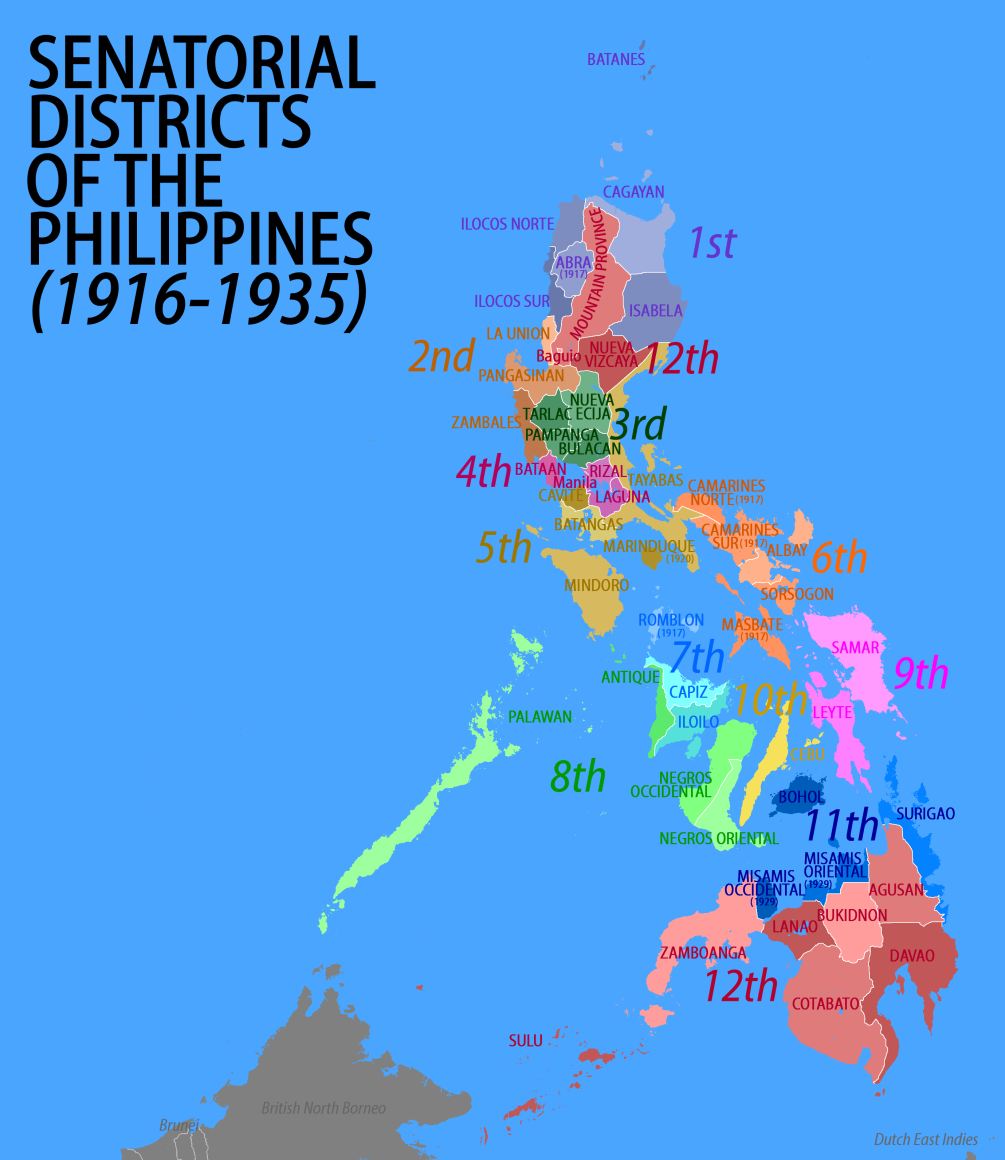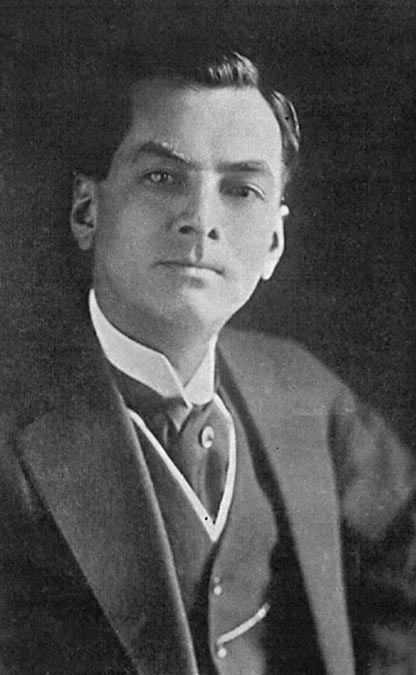|
Philippines's 10th Senatorial District
Philippines's 10th senatorial district, officially the Tenth Senatorial District of the Philippine Islands ( es, Décimo Distrito Senatorial de las Islas Filipinas), was one of the twelve senatorial districts of the Philippines in existence between 1916 and 1935. It elected two members to the Senate of the Philippines, the upper chamber of the bicameral Philippine Legislature under the Insular Government of the Philippine Islands for each of the 4th to 10th legislatures. The district was created under the 1916 Jones Law from the central Visayas province of Cebu. The district was represented by a total of five senators throughout its existence. It was abolished in 1935 when a unicameral National Assembly was installed under a new constitution following the passage of the Tydings–McDuffie Act which established the Commonwealth of the Philippines. Since the 1941 elections when the Senate was restored after a constitutional plebiscite, all twenty-four members of the upper hous ... [...More Info...] [...Related Items...] OR: [Wikipedia] [Google] [Baidu] |
Senatorial Districts Of The Philippines
The senatorial districts of the Philippines were the representations of the provinces of the Philippines in the Philippine Senate from 1916 to 1935. History The enactment of the Philippine Autonomy Act (popularly known as "Jones Law") in August 1916 by the United States Congress provided for the creation of a bicameral legislature consisting of a lower chamber (House of Representatives) and an upper chamber (Senate). Until then the Philippine Commission held the executive power and some legislative powers over the American colony. The system of government of the Philippines in its early years of transition to democratic self-government was deliberately structured to emulate the American model. The Philippines thus followed the American system of electing the members of the 24-seat senate by district. The districts were organized and numbered in a roughly north–south fashion, much like the present administrative regions. The first eleven districts were composed of establish ... [...More Info...] [...Related Items...] OR: [Wikipedia] [Google] [Baidu] |
Nacionalista Party
The Nacionalista Party (Filipino and Spanish: ''Partido Nacionalista''; ) is the oldest political party in both the Philippines and in Southeast Asia in general. It is responsible for leading the country throughout the majority of the 20th century since its founding in 1907; it was the ruling party from 1935 to 1946 (under Presidents Manuel L. Quezon and Sergio Osmeña), 1953–1961 (under Presidents Ramon Magsaysay and Carlos P. Garcia) and 1965–1972 (under President Ferdinand Marcos). Ideology The Nacionalista Party was initially created as a Filipino nationalist party that supported Philippine independence until 1946 when the United States granted independence to the country.Liow, J.; Leifer, M. (1995)''Dictionary of the Modern Politics of Southeast Asia'' New York: Routledge. Retrieved October 16, 2017. Since then, many scholarly articles that dealt with the history of political parties during the Third Republic agreed that the party has been increasingly populist,Celo ... [...More Info...] [...Related Items...] OR: [Wikipedia] [Google] [Baidu] |
8th Philippine Legislature
The Eighth Philippine Legislature was the meeting of the legislature of the Philippine Islands under the sovereign control of the United States from 1928 to 1930. Members Senate Notes House of Representatives Notes See also *Congress of the Philippines *Senate of the Philippines *House of Representatives of the Philippines The House of Representatives of the Philippines ( fil, Kapulungan ng mga Kinatawan ng Pilipinas, italic=unset, ''Kamara'' or ''Kamara de Representantes'' from the Spanish word ''cámara'', meaning "chamber") is the lower house of Congress, the ... External links * * Further reading *Philippine House of Representatives Congressional Library * * {{Philippine legislative periods 08 ... [...More Info...] [...Related Items...] OR: [Wikipedia] [Google] [Baidu] |
1928 Philippine Senate Elections
Legislative elections happened on June 5, 1928, in the Philippines under the Jones Law provisions. Electoral system In a staggered election, the seats of the senators who were first disputed in 1922 were up for election. The Philippines is divided into 12 senatorial districts, of which all districts save for the 12th district, has one of its seats up. In the 12th district, any vacancy is filled via appointment of the Governor-General. The election itself is via first-past-the-post. Results See also *8th Philippine Legislature *Commission on Elections *Politics of the Philippines *Philippine elections External linksOfficial website of the Commission on Elections {{Philippine elections 1928 Events January * January – British bacteriologist Frederick Griffith reports the results of Griffith's experiment, indirectly proving the existence of DNA. * January 1 – Eastern Bloc emigration and defection: Boris Bazhan ... 1928 elections in the Phili ... [...More Info...] [...Related Items...] OR: [Wikipedia] [Google] [Baidu] |
1925 Philippine Senate Elections
Senatorial elections happened on June 2, 1925 in the Philippines under the Jones Law provisions. Electoral system In a staggered election, the seats of the senators who were first disputed in 1919 were up for election. The Philippines is divided into 12 senatorial districts, of which all districts save for the 12th district, has one of its seats up. In the 12th district, any vacancy is filled via appointment of the Governor-General. The election itself is via first-past-the-post. Results See also *7th Philippine Legislature *Commission on Elections *Politics of the Philippines *Philippine elections External linksOfficial website of the Commission on Elections {{Philippine elections 1925 Events January * January 1 ** The Syrian Federation is officially dissolved, the State of Aleppo and the State of Damascus having been replaced by the State of Syria. * January 3 – Benito Mussolini makes a pivotal speech in the Italia ... 1925 elections in the Philippin ... [...More Info...] [...Related Items...] OR: [Wikipedia] [Google] [Baidu] |
Pedro Rodríguez (politician)
Pedro Rodríguez y Lazala (1869 – October 25, 1932), also known as Nyoy Endong and the Grand Old Man of Bogo was a Filipino politician. He served as ''Presidente Municipal'' of Bogo, Cebu and was one of the first members of the Philippine Assembly. Rodríguez was born in Medellin, Cebu and he attended the seminary of San Carlos and proceeded to the Ateneo de Manila where he graduated with a B.S. in Agricultural Engineering. He came from wealthy Bogo family with extensive landholdings in the northern sugar-belt towns of the province. Rodríguez was appointed as Municipal President of Bogo between 1898 until 1903. In 1905, he went to Spain as a delegate of the Philippine Assembly. In 1907, his brother, Celestino Rodríguez became senator deputised in the district. During his administration, he was part and given the leadership at the Inauguration of Independence held at the Old Plaza in Cebu, he said: "In our world, there are two respected mountains, namely Mount Sinai and Mo ... [...More Info...] [...Related Items...] OR: [Wikipedia] [Google] [Baidu] |
7th Philippine Legislature
The Seventh Philippine Legislature was the meeting of the legislature of the Philippines under the sovereign control of the United States from 1925 to 1928. Members Senate Notes House of Representatives Notes See also *Congress of the Philippines *Senate of the Philippines *House of Representatives of the Philippines The House of Representatives of the Philippines ( fil, Kapulungan ng mga Kinatawan ng Pilipinas, italic=unset, ''Kamara'' or ''Kamara de Representantes'' from the Spanish language, Spanish word ''cámara'', meaning "chamber") is the lower house ... External links * * Further reading *Philippine House of Representatives Congressional Library * * {{Philippine legislative periods 07 ... [...More Info...] [...Related Items...] OR: [Wikipedia] [Google] [Baidu] |
6th Philippine Legislature
The Sixth Philippine Legislature was the meeting of the legislature of the Philippines under the sovereign control of the United States from 1922 to 1925. Members Senate Notes House of Representatives Notes See also *Congress of the Philippines *Senate of the Philippines *House of Representatives of the Philippines The House of Representatives of the Philippines ( fil, Kapulungan ng mga Kinatawan ng Pilipinas, italic=unset, ''Kamara'' or ''Kamara de Representantes'' from the Spanish language, Spanish word ''cámara'', meaning "chamber") is the lower house ... External links * * Further reading *Philippine House of Representatives Congressional Library * * {{Philippine legislative periods 06 ... [...More Info...] [...Related Items...] OR: [Wikipedia] [Google] [Baidu] |
1922 Philippine Senate Elections
Senatorial elections were held on June 6, 1922 in the Philippines under the Jones Law provisions. It was controversial when Senate President Manuel L. Quezon accused Sergio Osmeña of using public funds in campaigning which resulted to the Nacionalista Party to be split. Electoral system In a staggered election, the seats of the senators who were first place in 1916 were up for election. The Philippines is divided into 12 senatorial districts, of which all districts save for the 12th district, has one of its seats up. In the 12th district, any vacancy is filled via appointment of the Governor-General. The election itself is via first-past-the-post. Results See also * 6th Philippine Legislature *Commission on Elections *Politics of the Philippines *Philippine elections External linksOfficial website of the Commission on Elections {{Philippine elections 1922 Events January * January 7 – Dáil Éireann (Irish Republic), Dáil Éireann, the parliament of the I ... [...More Info...] [...Related Items...] OR: [Wikipedia] [Google] [Baidu] |
1919 Philippine Senate Elections
Senatorial elections happened on June 3, 1919 in the Philippines under the Jones Law provisions. There were 717,295 registered voters, of whom 672,122, or 92 percent, voted. Electoral system In a staggered election, the seats of the senators who were second place in 1916 were up for election. The Philippines is divided into 12 senatorial districts, of which all districts save for the 12th district, has one of its seats up. In the 12th district, any vacancy is filled via appointment of the Governor-General. The election itself is via first-past-the-post. Results See also *5th Philippine Legislature *Commission on Elections *Politics of the Philippines *Philippine elections External linksOfficial website of the Commission on Elections {{Philippine elections 1919 Events January * January 1 ** The Czechoslovak Legions occupy much of the self-proclaimed "free city" of Pressburg (now Bratislava), enforcing its incorporation into the new republic of Czechoslovakia. ... [...More Info...] [...Related Items...] OR: [Wikipedia] [Google] [Baidu] |
5th Philippine Legislature
The Fifth Philippine Legislature was the meeting of the legislature of the Philippines under the sovereign control of the United States from 1919 to 1922. Members Senate Notes House of Representatives Notes See also *Congress of the Philippines *Senate of the Philippines *House of Representatives of the Philippines The House of Representatives of the Philippines ( fil, Kapulungan ng mga Kinatawan ng Pilipinas, italic=unset, ''Kamara'' or ''Kamara de Representantes'' from the Spanish language, Spanish word ''cámara'', meaning "chamber") is the lower house ... External links * * Further reading *Philippine House of Representatives Congressional Library * * {{Philippine legislative periods 05 ... [...More Info...] [...Related Items...] OR: [Wikipedia] [Google] [Baidu] |
Celestino Rodriguez
Celestino Lazala Rodriguez (May 11, 1872 – 1955) was a Filipinos, Filipino lawyer and politician from Cebu, Philippines. He served as member and deputy in the Philippine Assembly (1907–1912), as Senate of the Philippines, senator (1916–1922), member of the 1st National Assembly of the Philippines, 1st National Assembly (1935–1938), and 1st Congress of the Commonwealth of the Philippines, 1st Congress of the Commonwealth in 1945. Early life Celestino Rodriguez born to parents Jose Rodriguez and Vicenta Lazala in Bogo, Cebu, Bogo, Cebu on May 11, 1872, coming from a wealthy Bogo family with extensive landholdings in the northern sugar-belt towns of the province. He married Ignacia La Sala and had four children. At Ateneo de Manila University, Ateneo de Manila, he acquired a bachelor's degree in 1892 and a law degree from the Complutense University of Madrid, La Universidad Central de Madrid in 1900. Career Passing the bar and becoming a lawyer in 1902, Rodriguez pr ... [...More Info...] [...Related Items...] OR: [Wikipedia] [Google] [Baidu] |

